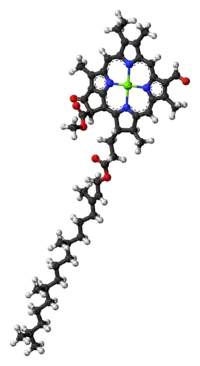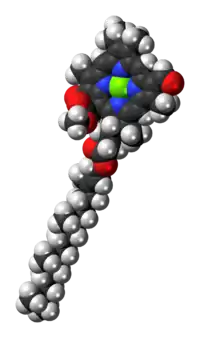Chlorophyll d
Chlorophyll d (Chl d) is a form of chlorophyll, identified by Harold Strain and Winston Manning in 1943.[1] It was unambiguously identified in Acaryochloris marina in the 1990s.[2] It is present in cyanobacteria which use energy captured from sunlight for photosynthesis.[3] Chl d absorbs far-red light, at 710 nm wavelength, just outside the optical range.[4] An organism that contains Chl d is adapted to an environment such as moderately deep water, where it can use far red light for photosynthesis,[5] although there is not a lot of visible light.[6]
 | |
| Identifiers | |
|---|---|
3D model (JSmol) |
|
| ChEBI | |
| ChemSpider | |
PubChem CID |
|
| UNII | |
CompTox Dashboard (EPA) |
|
| |
| |
| Properties | |
| C54H70MgO6N4 | |
Except where otherwise noted, data are given for materials in their standard state (at 25 °C [77 °F], 100 kPa).
Infobox references | |
Chl d is produced from chlorophyllide d by chlorophyll synthase. Chlorophyllide d is made from chlorophyllide a, but the oxygen-using enzyme that performs this conversion remains unknown as of 2022.[7]
 |  |
| Ball-and-stick model | Space-filling model |
References
- Manning WM, Strain HH (November 1943). "Chlorophyll d, a green pigment of red algae" (PDF). Journal of Biological Chemistry. 151 (1): 1–9. doi:10.1016/S0021-9258(18)72109-1.
- Larkum AW, Kühl M (August 2005). "Chlorophyll d: the puzzle resolved" (PDF). Trends in Plant Science. 10 (8): 355–7. doi:10.1016/j.tplants.2005.06.005. PMID 16019251. Archived from the original (PDF) on 2012-03-13. Retrieved 2014-11-17.
- "Photosynthetic Pigments". University of California Museum of Paleontology.
- "Scientists discover first new chlorophyll in 60 years". PHYS ORG. August 20, 2010.
- "Researchers decode genetics of chlorophyll d". News Medical Life Sciences. AZO Network.
- "Chlorophyll d". Biology Online. 7 October 2019.
- Tsuzuki, Yuki; Tsukatani, Yusuke; Yamakawa, Hisanori; Itoh, Shigeru; Fujita, Yuichi; Yamamoto, Haruki (29 March 2022). "Effects of Light and Oxygen on Chlorophyll d Biosynthesis in a Marine Cyanobacterium Acaryochloris marina". Plants. 11 (7): 915. doi:10.3390/plants11070915. PMC 9003380.